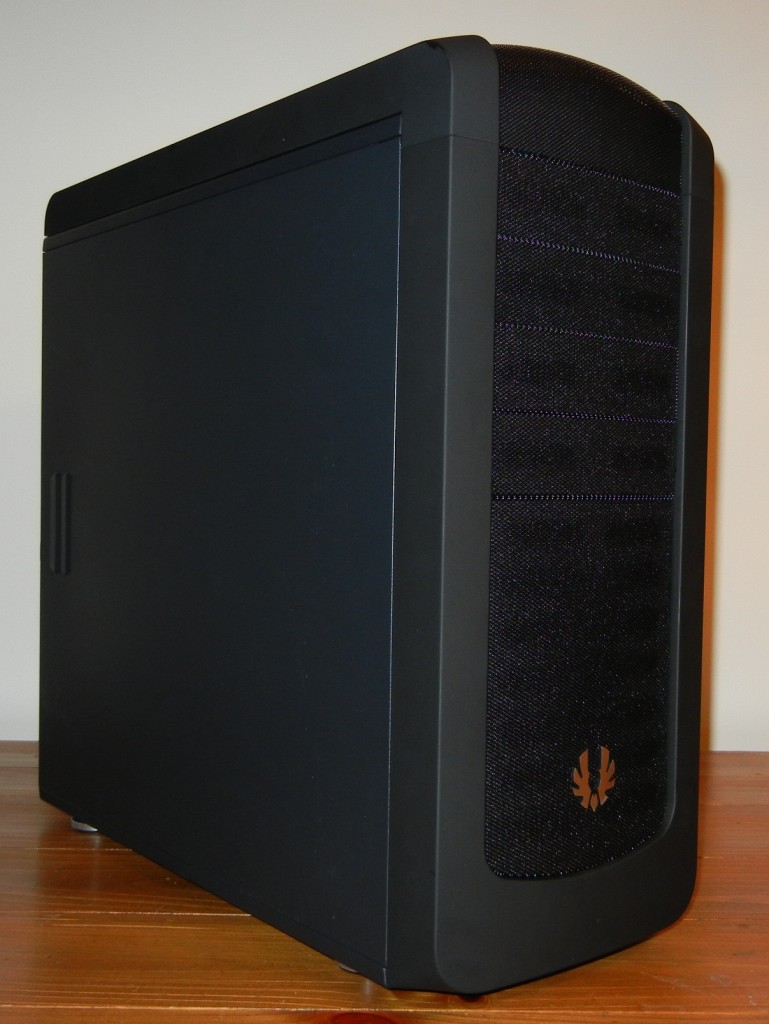BitFenix may be known to many of you for their sleek and innovative case designs, which allow them to stand out against the competition.
It is their attention to detail, both inside and out, that enables them to catch the eye of potential consumers.
Today, we will be looking at their latest Raider model, which looks primed to continue the tradition of enclosure design excellence. Lets find out if it succeeds.
SPECIFICATIONS
| Materials | Steel, Plastic |
| Dimensions | 210 x 500 x 493mm (ATX Mid Tower) |
| Motherboard Sizes | Mini-ITX, mATX, ATX |
| 5.25″ Drive Bays | x 4 |
| 3.5″ Drive Bays | x 6 |
| 2.5″ Drive Bays | x 7 |
| Cooling Front | 2 x 120mm (included) or 1 x 200mm (optional) |
| Cooling Rear | 1 x 120mm (included) |
| Cooling Top | 1 x 200mm (optional) |
| Cooling Bottom | 1 x 120mm (optional) |
| PCI Slots | x 7 |
| I/O | 4 x USB3.0, HD Audio |
| Power Supply | PS2 ATX (bottom, multi direction) |
EXTERIOR
One of the first things to be noticed is the rubber coating which envelopes most of the case. Dubbed SofTouch, this is quite a nice feature, as it helps prevent the unfettered proliferation of fingerprints which can potentially detract from the elegance of this magnificent monolith.
 Its also apparently quite resistant to scratches, though I have to say, I am a bit reticent when it comes to testing that claim on the case we have here today, as I dont think the weathered look would really go well with the Raider. Perhaps one of our readers has an enclosure theyd be willing to experiment on : ) ?
Its also apparently quite resistant to scratches, though I have to say, I am a bit reticent when it comes to testing that claim on the case we have here today, as I dont think the weathered look would really go well with the Raider. Perhaps one of our readers has an enclosure theyd be willing to experiment on : ) ?
Certainly, it seems that BitFenix has taken the understated route when it comes to the Raider, which lacks anything in the way of side windows or even LED fans. Personally I like the fact that the company has shown some restraint with their latest offering, especially with seemingly every other case on the market giving consumers copious amounts of LEDs as well as, in many cases, garish front bezel designs which have enough aesthetic appeal to trigger an epileptic fit. Simple and stately chassis really have become the minority, serving as a refreshing alternative.
Ah, how I long for the days when having a case window was reflective of skill with a dremel, rather than being speedy with a debit card.
Moving to the top of the case, we can see the fanbus controller as well as the four USB 3.0 ports BitFenix is so proud of. The built in fanbus has connectors for up to five fans, though three of them are occupied by the included 120mm Spectre fans, which should please anyone wanting an almost spookily quiet system. Users can opt for an even quieter case by using the slider to adjust the fan speed to even lower RPMs. One additional benefit of a fan controller is that it should help cut down on cable clutter, as case cooling no longer has to be routed to the motherboard. Those of us whove been in the situation where we have more fans than motherboard headers can definitely appreciate this feature!
 On the other side, we have the four USB 3.0 ports, which are arranged in a vertical line. Considering that many motherboards dont offer connections for more than one SuperSpeed socket, its a good thing BitFenix had the foresight to add a standard internal USB connector to each of the wire harnesses, helping ensure that the external ports can be utilized by the majority of end users. Used for USB 3.0 or not, these ports are a nice addition, and should extend the useful life of the Raider across at least a few generations of builds. Keep your fingers crossed that in the not too distant future, the majority of motherboards will be able use the Raider to its full potential.
On the other side, we have the four USB 3.0 ports, which are arranged in a vertical line. Considering that many motherboards dont offer connections for more than one SuperSpeed socket, its a good thing BitFenix had the foresight to add a standard internal USB connector to each of the wire harnesses, helping ensure that the external ports can be utilized by the majority of end users. Used for USB 3.0 or not, these ports are a nice addition, and should extend the useful life of the Raider across at least a few generations of builds. Keep your fingers crossed that in the not too distant future, the majority of motherboards will be able use the Raider to its full potential.
Before we go any further, here is an overview by BitFenix themselves……
 The SSD Review The Worlds Dedicated SSD Education and Review Resource |
The SSD Review The Worlds Dedicated SSD Education and Review Resource | 